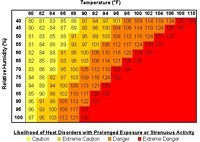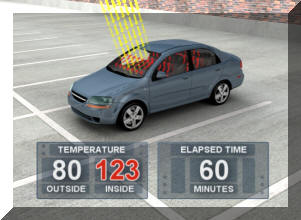Heat is the number one weather-related killer in the United States, resulting in hundreds of fatalities each year. In fact, on average, excessive heat claims more lives each year than floods, lightning, tornadoes and hurricanes combined. In the disastrous heat wave of 1980, more than 1,250 people died. In the heat wave of 1995 more than 700 deaths in the Chicago area were attributed to heat. In August 2003, a record heat wave in Europe claimed an estimated 50,000 lives.
North American summers are hot; most summers see heat waves in or more parts of the United States. East of the Rockies, they tend to combine both high temperature and high humidity; although some of the worst heat waves have been catastrophically dry.
Additional detail on how heat impacts the human body is provided under "The Hazards of Excessive Heat" heading.
NOAA's Watch, Warning, and Advisory Products for Extreme Heat
Each National Weather Service Weather Forecast Office can issue the following heat-related products as conditions warrant:
Excessive Heat Outlooks : are issued when the potential exists for an excessive heat event in the next 3-7 days. An Outlook provides information to those who need considerable lead time to prepare for the event, such as public utilities, emergency management and public health officials. See the mean heat index and probability forecasts maps.Excessive Heat Watches: are issued when conditions are favorable for an excessive heat event in the next 12 to 48 hours. A Watch is used when the risk of a heat wave has increased, but its occurrence and timing is still uncertain. A Watch provides enough lead time so those who need to prepare can do so, such as cities who have excessive heat event mitigation plans.
Excessive Heat Warnings/Advisories: are issued when an excessive heat event is expected in the next 36 hours. These products are issued when an excessive heat event is occurring, is imminent, or has a very high probability of occurring. The warning is used for conditions posing a threat to life or property. An advisory is for less serious conditions that cause significant discomfort or inconvenience and, if caution is not taken, could lead to a threat to life and/or property.
How Forecasters Decide Whether to Issue Excessive Heat Products
NOAA's heat alert procedures are based mainly on Heat Index Values. The Heat Index, sometimes referred to as the apparent temperature and given in degrees Fahrenheit, is a measure of how hot it really feels when relative humidity is factored with the actual air temperature.
To find the HI, look at the Heat Index Chart. As an example, if the air temperature is 96°F (found on the top of the table) and the RH is 65% (found on the left of the table), the HI-or how hot it really feels-is 121°F. This is at the intersection of the 96° column and the 65% row. The National Weather Service will initiate alert procedures when the Heat Index is expected to exceed 105°- 110°F (depending on local climate) for at least 2 consecutive days
 IMPORTANT: Since HI values were devised for shady, light wind conditions, EXPOSURE TO FULL SUNSHINE CAN INCREASE HI VALUES BY UP TO 15°F. Also, STRONG WINDS, PARTICULARLY WITH VERY HOT, DRY AIR, CAN BE EXTREMELY HAZARDOUS.
IMPORTANT: Since HI values were devised for shady, light wind conditions, EXPOSURE TO FULL SUNSHINE CAN INCREASE HI VALUES BY UP TO 15°F. Also, STRONG WINDS, PARTICULARLY WITH VERY HOT, DRY AIR, CAN BE EXTREMELY HAZARDOUS.
Note on the Heat Index Chart shaded zone above 105°F. This corresponds to a level of HI that may cause increasingly severe heat disorders with continued exposure and/or physical activity.
The Hazards of Excessive Heat
Heat disorders generally have to do with a reduction or collapse of the body's ability to shed heat by circulatory changes and sweating or a chemical (salt) imbalance caused by too much sweating. When the body heats to quickly to cool itself safely, or when you lose much fluid or salt through dehydration or sweating, your body temperature rises and heat-related illness may develop. Heat disorders share one common feature: the individual has been in the heat too long is exercised too much for his or her age and physical condition.
Studies indicate that, other things being equal, the severity of heat disorders tend to increase with age. Conditions that cause heat cramps in a 17-year-old may result in heat exhaustion in someone 40, and heat stroke in a person over 60.
Sunburn, with its ultraviolet radiation burns, can significantly retard the skin's ability to shed excess heat.
Acclimatization has to do with adjusting sweat-salt concentrations, among other things. The idea is to lose enough water to regulate body temperature, with the least possible chemical disturbance/salt depletion.
Children, Adults and Pets Enclosed in Parked Vehicles Are at Great Risk
Each year children die from hyperthermia as a result of being left in parked vehicles. Hyperthermia is an acute condition that occurs when the body absorbs more heat than it can dissipate. Hyperthermia can occur even on a mild day. Studies have shown that the temperature inside a parked vehicle can rapidly rise to a dangerous level for children, adults and pets. Leaving the windows slightly open does not significantly decrease the heating rate. The effects can be more severe on children because their bodies warm at a faster rate than adults. Hyperthermia deaths aren't confined to summer months. They also happen during the spring and fall.
Shown below is a time lapse photo of a thermometer reading in a car over a period of less than an hour. As the photograph shows, in just over 2 minutes the car went from a safe temperature to 94.3 degree F. These photos demonstrate just how quickly a vehicle can become a death trap for a child.
How Fast Can the Sun Heat A Car?
The atmosphere and the windows of a car are relatively “transparent” to the sun’s shortwave radiation (yellow in figure below) and are warmed little. This shortwave energy, however, does heat objects it strikes. For example, a dark dashboard or seat can easily reach temperatures in the range of 180 to more than 200 degrees F.
These objects (e.g., dashboard, steering wheel, childseat) heat the adjacent air by conduction and convection and also give off longwave radiation (red) which is very efficient at warming the air trapped inside a vehicle.
Objects Heated by the Sun Warm Vehicle's Air
CLICK HERE FOR ANIMATION (700K)
( Hi-Res ~ 2.5 mb.WMV file)
Individual Frames:
0 min, 10 min, 20 min, 30 min, 40 min, 50 min, 60 min
(Animation Courtesy of General Motors and Golden Gate Weather Services. Use of this animation does not imply NWS endorsement of services provided by General Motors and Golden Gate Weather Services)
Heat Safety
Child Safety Tips
- Make sure your child's safety seat and safety belt buckles aren't too hot before securing your child in a safety restraint system, especially when your car has been parked in the heat.
Never leave your child unattended in a vehicle, even with the windows down.
Teach children not to play in, on or around cars.
Always lock car doors and trunks--even at home--and keep keys out of children's reach.
Always make sure all children have left the car when you reach your destination. Don't leave sleeping infants in the car ever!
Adult Heat Wave Safety Tips
Slow down. Reduce, eliminate or rescheduled strenuous activities until the coolest time of the day. Children, senior and anyone with health problems should stay in the coolest available place, not necessarily indoors.
Dress for summer. Wear lightweight, light-colored clothing to reflect heat and sunlight.
Put less fuel on your inner fires. Foods, like meat and other proteins that increase metabolic heat production also increase water loss.
Drink plenty of water or other non-alcohol or decaffeinated fluids. Your body needs water to keep cool. Drink plenty of fluids even if you don't feel thirsty. Persons who have epilepsy or heart, kidney, or liver disease, are on fluid restrictive diets or have a problem with fluid retention should consult a physician before increasing their consumption of fluids. Do not drink alcoholic beverages and limited caffeinated beverages.
During excess heat period, spend more time in air-conditioned places. Air conditioning in homes and other buildings markedly reduces danger from the heat. If you cannot afford an air conditioner, go to a library, store or other location with air conditioning for part of the day.
Don't get too much sun. Sunburn reduced your body's ability to dissipate heat.
Do not take salt tablets unless specified by a physician.
Heat Disorder Symptoms
SUNBURN: Redness and pain. In severe cases swelling of skin, blisters, fever, headaches. First Aid: Ointments for mild cases if blisters appear and do not break. If breaking occurs, apply dry sterile dressing. Serious, extensive cases should be seen by physician.
HEAT CRAMPS: Painful spasms usually in the muscles of legs and abdomen. Heavy sweating. First Aid: Firm pressure on cramping muscles or gentle massage to relieve spasm. Give sips of water. If nausea occurs, discontinue water.
HEAT EXHAUSTION: Heavy sweating, weakness, skin cold, pale and clammy. Pulse thready. Normal temperature possible. Fainting and vomiting. First Aid: Get victim out of sun. Once inside, the person should lay down and loosen clothing. Apply cool, wet cloths. Fan or move victim to air conditioned room. Offer sips of water. If nausea occurs, discontinue water. If vomiting continues, seek immediate medical attention.
HEAT STROKE (or sunstroke): High body temperature (106° F or higher). Hot dry skin. Rapid and strong pulse. Possible unconsciousness. First Aid: HEAT STROKE IS A SEVERE MEDICAL EMERGENCY. SUMMON EMERGENCY MEDICAL ASSISTANCE OR GET THE VICTIM TO A HOSPITAL IMMEDIATELY. DELAY CAN BE FATAL. White waiting for emergency assistance, move the victim to a cooler environment Reduce body temperature with cold bath or sponging. Use extreme caution. Remove clothing, use fans and air conditioners. If temperature rises again, repeat process. Do not give fluids. Persons on salt restrictive diets should consult a physician before increasing their salt intake.
For more information contact your local American Red Cross Chapter. Ask to enroll in a first aid course.
Community Guidance: Preparing for and Responding to Excessive Heat Events
The Excessive Heat Events Guidebook was developed by the Environmental Protection Agency (EPA) in 2006, in collaboration with the National Weather Service, the Centers for Disease Control and Prevention, and theDepartment of Homeland Security. This guidebook provides best practices for saving lives during heat waves in urban areas, and provides a menu of options that communities can use in developing their own mitigation plans. Beat the Heat is also available in Spanish/Espanol.
Worker Safety: Outdoor workers can be especially vulnerable to excessive heat. See Occupational Safety and Health Administration (OSHA) resources and recommended practices (planning, prevention, and response) when working under hot conditions, such as drinking fluids, changing work/rest schedules to lengthen breaks, cooling down in shade, and looking out for co-workers, particularly those who work alone. Check weather forecasts ahead of time so that you can be better prepared.
Produced as a cooperative effort of NOAA's National Weather Service, the Federal Emergency Management Agency, Occupational Safety and Health Administration, Center for Disease Control, and the American Red Cross.





